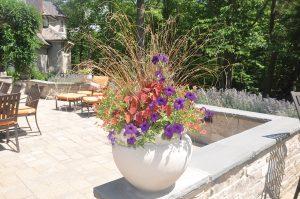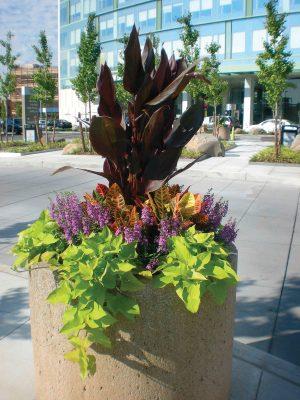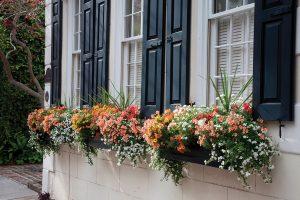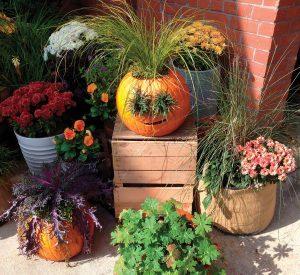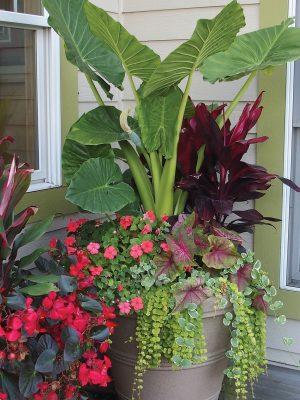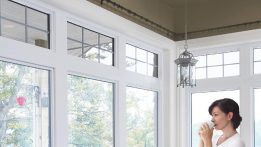(WARNING – Don’t Read This If You Are an Expert Gardener)
Not many people have large, expansive gardens, but we all have at least one small barren pot or space. Perhaps, “Thriller, Filler and Spiller” is the ultimate catch phrase for container gardening, but the ideas can be applied to other small garden areas besides an empty container.
Find a plant that is a thriller or one that is taller and more spectacular. Place it in the center or center back of the container or small plot. Next, pick out plants that flourish in the same light, water and soil requirements as the thriller, and plant these around it toward the center of the pot or area. These are the fillers. Finally, pick out plants of similar cultural requirements and plant these along the container or the bed edges. These are the spillers. Voila! Gardening in a small space made easy but with BIG impact. Small, smart and simple!
All gardening in small spaces does not have to be in a container, but it is a good place to start and learn. Great thriller plants for a sunny container are tall grasses, such as Purple Fountain Grass (Pennisetum setaceum ‘Rubrum’), Yucca filamentosa ‘Gold Edge’, a Banana (Musa spp.) or a Canna (Canna ‘Pretoria’, ‘Tropicanna’, or ‘Black Knight’). Add 3 to 5 filler plants of the same type such as Pentas spp., Dusty miller (Centaurea cineraria), Supertunia petunia ‘Bubblegum’ or Lantanas for the sun. Finally, tuck in 3 to 5 of the same sun loving spillers like sweet potato vine ( Ipomoea batatas ‘Margarita’), Golden Creeping Jenny (Lysimachia nummularia), or Sedum upestre ‹Angelina›.
For a shade container thriller, try caladiums such as ‘Carolyn Whorton’, ‘Candidum’, ‘White Christmas’ or ‘Red Flash’. Another great summer thriller is hosta. In our warm climate, hostas grow bigger more quickly in a pot as hostas need colder roots. Try one of the newer hostas similar to ‘Guacamole’, ‘Big Daddy’, ‘Blueberry Muffin’ or any with rounder, thicker, cupped, non-variegated and puckered leaves. For a filler in the shade, utilize Coleus (Solenostemon scutellarioides), Persian shield (Strobilanthes dyerianus, Coral bells (Heuchera) or Plectranthus (Plectranthus spp.). For the shade spiller, tuck in plants such as Cane Begonia ‘Lana’, Summer Wave Large Blue Torenia ‘SUNrenilabu’ or Variegated Vinca Vine Vinca major ‘variegata’ or similar cultivars.
If you are not familiar with these plants, search for images of them on the internet to see what pleases you the most. All are readily available locally, but you might have to select a different cultivar. If so inclined, mix the textures (smooth or rough) and shape of the leaves or flowers (round or pointy.) Mix the colors of the leaves or flowers also for contrast. Local nursery staff can help you with your selections, and many plants come with helpful information tags to guide your selections. If you are an “Experimental Gardener”, as most of us are, do not worry too much as most containers decline after a season or so, making the fun of creating a beautiful arrangement start all over again. Furthermore, make sure that your container or pot has a hole in the bottom for drainage, and remember you can always move a pot from sun to shade or vice-versa as the seasons change.
Say you like containers, but you really want to do something in your yard. By and large, you will be successful in your yard if you use shade loving plants in the shade and sun loving plants in the sun. Sounds simple, right? Well…be very careful of pass-along plants from a friend or relative. It may be an exotic invasive plant! Hence, the reason your “friend” has so much to share!
Local nursery staff are great to answer questions about a specific plant, but do a little homework ahead so you can ask great questions. You want to select the right plant for the right place. This is really important in our Florida climate where plants can get quite a bit larger than the norm.
Drive through any established neighborhood and you will see plants that are too close to foundations, making inviting environments for all sorts of bugs and critters. If you notice spindly, wimpy plants with little green on the bottom, chances are they aren’t getting enough light. If you see a plant taller and wider than a picture window, the window might as well be boarded up. Don’t plant in little spaces next to garage doors, sidewalks or other structures. Make a container garden and set it in that area. You can then control the size of the planting or just move the pot!
Start simple with one new plant bed. Look around your yard for that bare, neglected spot where grass just will not grow. (Chances are it is too shady there for grass.) Think back to the “Thriller, Filler and Spiller” concept. Pick a tall woody ornamental (bush) that does well in the shade or one that does well in part shade, such as Fatsia japonica, Florida anise (Illicium floridanum), or Hydrangea paniculata ‘Limelight’, and place it in the center back. You get to decide which is the back and front of this new bed. Then select a perennial (comes back every year or doesn’t ever completely die) for the middle, like Aquilegia canadensis (Columbine), Dryopteris erythrosora (Autumn fern) or Adiantum pedatum (Maidenhair fern). Plant odd numbers, 3 or 5, depending on how big the bed is and remembering how big at maturity the perennial gets. Then tuck some more perennials or annuals (one-season plants such as Coleus or Begonias) around the edges. If you don’t mind changing things up every season, plant what you like. Again, start small with one bed so you won’t get overwhelmed. You might try Petroselinum crispum (parsley) to work in an herb or small tomatoes like Solanum lycopersicum ‘Tommy Toe’ if you have more sun around the edges.
I have mentioned a few native plants (to our area), so don’t leave native plants off your list. Just be sure that you obtain them locally and legally. Of course, you can get way more complicated as your skill level rises, and you are rewarded with a beautiful bed. Thinking one section or container at a time keeps you from getting ahead of your time, patience and pocketbook. Unless you have an unlimited amount of money and time, do your research and plan. Find a small spot in your yard that you walk by every day and get started making it eye candy that brightens your day. ![]()
Lana Arnold
Member of Tallahassee Garden Club & Board of Trustees
IFAS Master Gardener Volunteer since 2005


